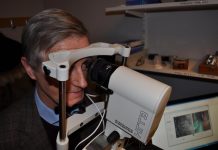4 June, 2002 - Australian research has led to clinical trials of a drug that could provide a painless and non-destructive way to treat blindness in diabetics.
The University of Melbourne-led pre-clinical research prompted the world-wide, multi-centre clinical trial following the announcement of their results at an international conference last year. The drug blocks a crucial pathway whose end products cause blindness and eye damage in diabetics, the leading cause of new blindness in adults around the world. The trial will begin later this year. JOURNALISTS AND EDITORS: A high-resolution version of this image is available for downloading. Click once on the image you want, and save the file onto your hard disk. This may take a few minutes.
A look inside the eye a diabetic patient suffering retinopathy. Arrow A points to what a healthy eye blood vessel should look like. B and C are signs of the degenerative effects of retinopathy. A - healthy blood vessel B - dying blood vessel C - dilated vessel. This occurs as the vessel walls weaken and lose their elastic strength
The research team's success also caught the attention of funding agencies. The US-based Juvenile Diabetes Research Foundation (JDRF), the world's leading non-profit, non-governmental funder of diabetes research and the National Health and Medical Research Council (NHMRC) have granted the University of Melbourne team $4.7 million in funding over five years. The funds will help refine their understanding of the chemical pathways that lead to blindness (diabetic retinopathy) and kidney failure (diabetic nephropathy) in diabetics and to find new drugs to combat the disease.
A vital clue to our breakthrough came unexpectedly when treating diabetics for high blood pressure, another consequence of the disease,� says Dr Jennifer Wilkinsonson-Berka, Head of Diabetes and Vascular Biology Laboratory, University of Melbourne.
Continue Reading Below ↓↓↓
Wilkinson-Berka's team and other researchers working in this area found that common drugs used to treat high blood pressure also improved kidney problems. The chemical system in the body that caused high blood pressure in diabetics was found to be the same culprit behind kidney failure.
The system, called Renin-Angiotensin System (RAS) is triggered by high blood glucose levels and its end product is a protein call angiotensin that causes cells to grow.
Drugs used to treat high blood pressure block the chemical pathway in RAS that produces angiotensin.
Diabetic patients now take these drugs to treat kidney damage, but nobody had thought to look if RAS also operated in the eye,� says Wilkinson-Berka.
Using a diabetic rat model with an enhanced RAS that the team developed specifically for their diabetic research, they quickly discovered that RAS was present and active in the eye when blood glucose reached high levels.
The diabetic rats also allowed us to test various drugs that attack the pathways affected by or involving glucose, including two angiotensin-blocking drugs similar to the new drug to be used in the clinical trial,� says Wilkinson-Berka.
We found that these drugs successfully prevented the growth of blood vessels in the eye and kidney. It was this success that led to the funding for, and approval of the clinical trial,� she says.
Diabetic retinopathy occurs when the tiny blood vessels of the retina are damaged. The retina is a thin light-sensitive tissue at the back of the eye that transmits visual images to our brain.
The eye's vessels are extremely delicate. Angiotensin may cause the blood vessels to grow too fast and they fail to form properly. This causes the vessels to bleed and gradual detachment of the retina to occur. Similar damage occurs to the blood vessels in the kidney, eventually leading to kidney failure.
Current treatment for retinopathy is to burn hundreds of tiny holes into the retina with a laser to burn away damaged blood vessels. While effective, it is a damaging procedure causing loss of peripheral vision and it fails to prevent the problem re-occurring.
Continue Reading Below ↓↓↓
We are aiming for a non-destructive, preventative treatment that doesn't involve destroying retina or requiring a kidney transplant,� says Wilkinson-Berka.
More than 100,000 Australians have type 1 juvenile diabetes. It strikes suddenly and makes the recipient insulin dependent for life. With type 1 diabetes, the body's immune systems attacks and destroys the insulin-producing cells of the pancreas.
Insulin and a controlled diet do not cure diabetes, nor does it prevent the eventual and devastating effects such as kidney failure, nerve damage, amputations and blindness.
The JDRF and NHMRC grant will enable Dr Wilkinson-Berka's team to find other pathways and hormonal systems involved in nephropathy and retinopathy, and potential drugs to block these pathways.
It is hoped that drugs such as the one being tested will retard or prevent visual impairment and blindness in diabetic patients. It will be a major advance in the treatment of a disease that affects a large proportion of the population including children and young adults,� she says.
The research team includes Associate Professor Richard Gilbert and Dr Darren Kelly, Medicine, St Vincent's Hospital; Associate Professor Rik Thompon and Dr Mark Waltham, St Vincent's Institute; Professor George Werther and Dr Chris Wraight, Murdoch Children's Research Institute and Royal Children's Hospital; Professor Carol Pollock and Dr Philip Poronik, University of Sydney, Royal North Shore Hospital; Associate Professor Silviu Itescu, Columbia University, New York.
Source: University of Melbourne










